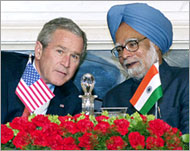Nasa hitches ride on India moonshot
An unmanned Indian mission to the Moon will carry two Nasa devices designed to find minerals and ice on the lunar surface.

The deal was sealed on Tuesday between Nasa and the Indian Space Research Organisation, ISRO, in the southern Indian city of Bangalore.
The mission, called Chandrayaan-1, is set to launch next year or in 2008, according to the ISRO website, and will map the lunar surface using an array of sensors.
The collaboration – initially agreed on during a visit to India in March by George Bush, the US president – calls for two Nasa payloads to be carried to the Moon by a 525kg spacecraft.
Ice and minerals
One of the American devices, a mini-synthetic aperture radar, will map ice deposits in the Moon’s polar regions.
The other instrument, called a moon mineralogy mapper, will assess mineral resources, a US embassy spokesman in New Delhi said.
|
“As we extend the reach of human civilisation throughout the solar system, the US and India will be partners on many more technically challenging and scientifically rewarding projects” Michael Griffin, the head of Nasa |
Chandrayaan-1 will also carry three scientific instruments from European research centres.
The deal was signed by Nasa’s chief, Michael Griffin, and the chairman of ISRO, G Madhavan Nair.
Partnership
India received 16 proposals from around the world to be a part of the mission.
“Of these we selected six instruments including two from the US,” Nair said. “Today is an important milestone in the cooperation between Nasa and ISRO.”
After the signing, Griffin said he hoped that “as we extend the reach of human civilisation throughout the solar system, the US and India will be partners on many more technically challenging and scientifically rewarding projects”.
Ties between New Delhi and Washington reached a low point when the United States and other Western nations imposed economic sanctions on India after it tested nuclear weapons in 1998. Most sanctions have since been lifted.
The sanctions delayed ISRO’s plans to develop its own engine for launching space vehicles.
Remaining sanctions
 |
|
The co-operation programme was |
But ISRO’s chief pointed out after the signing ceremony that
sanctions remained on three of its operations and urged Washington to lift them to allow for more high-tech imports.
Madhavan Nair restrictions were still applied to ISRO’s Vikram Sarabhai Space Centre, Liquid Propulsion Systems Centre in Kerala state and Satish Dhawan Space Centre in Andhra Pradesh.
“As an effort between our prime minister and President George Bush three [other] institutions were removed from the list to enable import of more high-tech imports and services from the US,” Nair said.
“I hope this will encourage an improvement in space commerce activity in the coming years. I can see that there is a willingness on both sides to improve this co-operation.”
India began its space programme in 1972, and has previously used engines from long-time ally Russia to launch satellites.